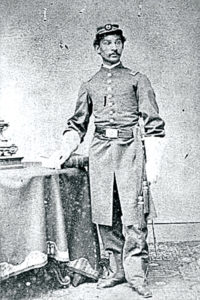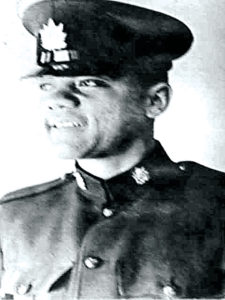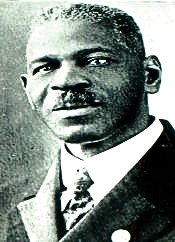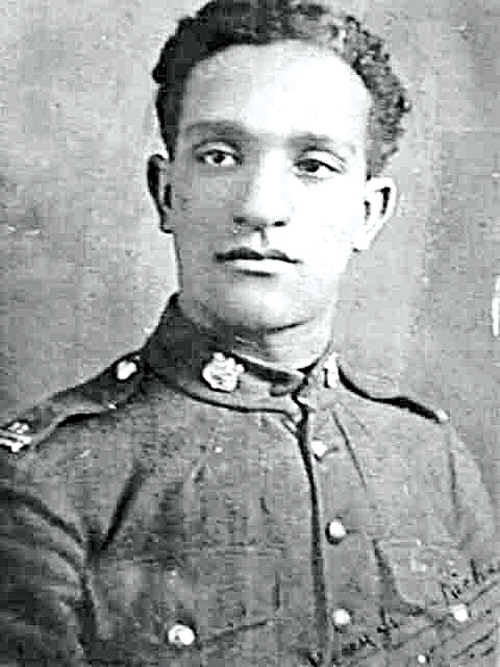Remembering the contributions of Black soldiers
Petura Burrows
BHM supplement Coordinator
 October 13, 1812. Canada meets America in war. For American Major-General Stephen Van Rensselaer, today should be an easy conquest, a “mere matter of marching” into Upper Canada by crossing the Niagara River. But Canadian soldiers, under the leadership of Major-General Isaac Brock, wait at Queenston Heights to protect their border against the coming American army. Brock charges the enemy. A bullet pierces Brock’s flesh. He dies.
October 13, 1812. Canada meets America in war. For American Major-General Stephen Van Rensselaer, today should be an easy conquest, a “mere matter of marching” into Upper Canada by crossing the Niagara River. But Canadian soldiers, under the leadership of Major-General Isaac Brock, wait at Queenston Heights to protect their border against the coming American army. Brock charges the enemy. A bullet pierces Brock’s flesh. He dies.
It looks like Canada has lost this battle, when, suddenly, a band of Canadian reinforcements—the “Company of Coloured Men” (or Coloured Corps) and their white captain, Robert Runchey; Major-General Roger Sheaffe’s regiment; and Captain John Norton’s First Nations regiment —attack from the rear, pinning the American army against a cliff. The Battle of Queenston Heights ends with the surrender of the Americans.
Not only was that battle a significant victory for Canada, it signaled an affirmation of the Black man in Canada. This “Company of Coloured Men,” a band of thirty African-Canadian men, some freed slaves, some indentured servants, had been granted the right to fight for their country.
The formation of this regiment came about through a petition by Richard Pierpoint, a Black Loyalist, and war veteran who had fought with Butler’s Rangers during the American Revolution. His initial proposal to form a coloured group of fighters was dismissed by Major-General Brock—a theme that would resonate throughout Canada’s military history.
This year, as Canada commemorates the bicentennial anniversary of the War of 1812, we have the ideal opportunity to examine the legacy of these African-Canadian soldiers upon whose backs the war history of Canada was carried. We must share these stories, lest we forget that coloured blood was spilled as well.
 “Too often, African-Canadian students feel that they don’t belong because aspects of their cultural history is excluded or misrepresented. A disconnection occurs for many African-Canadian children who ask their teachers about the presence of Black settlers in Canada, only to be misinformed that no one looking like them was part of Canada’s first colonies,” says Natasha Henry, education specialist at York’s Harriet Tubman Institute for Research on the Global Migrations of African Peoples.
“Too often, African-Canadian students feel that they don’t belong because aspects of their cultural history is excluded or misrepresented. A disconnection occurs for many African-Canadian children who ask their teachers about the presence of Black settlers in Canada, only to be misinformed that no one looking like them was part of Canada’s first colonies,” says Natasha Henry, education specialist at York’s Harriet Tubman Institute for Research on the Global Migrations of African Peoples.
“Learning about their ancestors can support the enhancement of pride, self-worth, and a sense of belonging. It can empower African-Canadian students to set and pursue higher goals as they become more engaged in their learning and uncover examples of African-Canadian determination, success, and courage. So there is power in remembrance.”
According to Henry, Black men have served in every major British war and conflict in North America. Yet, their contributions are not recognized in “the mainstream Canadian narrative.”
These were men like Pierpoint, who served in Butler’s Rangers, an all-Black militia stationed at, New York’s Fort Niagara just at the shore of Lake Ontario.These were men like the Victoria African Rifles in British Columbia, the only armed corps protecting Vancouver Island in 1861 (for that one year) against the threat of American invasion. And of course, these were men like Runchey’s Company of Coloured Men who aided in Canada’s success at Queenston Heights. The Company of Coloured Men, then renamed the “Coloured” or “Black” Corps, served as part of the regiment who fought to defend Niagara on the lake and Fort George against the US army and navy’s attack on May 27, 1813.
While the Coloured Corps may have lost that battle, it could be argued that through the precedent they set as the first all-Black militia, they began to win the fight for Black inclusion in war. During the rebellions of 1837-38, the need to secure the borders caused several coloured corps to form. They were called the 1st and 2nd Coloured Corps from the Chatham and Windsor area, under Captain Caldwell and Josiah Henson; the Coloured Corps of Upper Canada in the Niagara region; and the Toronto Coloured Corps, led by Colonel Samuel Jarvis.
Still, the Black man’s fight for inclusion in Canada’s militia was not complete. During World War 1, rampant racism and segregation in Canada proved a hurdle for Black men who wanted to enlist.
In October 1914, the first troops left Québec City en route to England and the battlefields of Belgium and France. According to Calvin Ruck’s book, Canada’s Black Battalion: No. 2 Construction, a few Black men were in that number since individual Blacks could enlist as long as they were accepted. Throughout Canada, Black volunteers were being rejected due to their race. Some volunteers were rejected, with the statement that World War 1 was no place for a Black man, as it was a “white man’s war.”
Other subtle but equally disingenuous reasons for rejecting Black volunteers involved concerns that “it would be humiliating to the coloured men themselves to serve in a battalion where they were not wanted.”
On December 22, 1915, Major-General Gwatkin penned these words in a memorandum, along with what could be considered a contradictory statement: “The fiat has gone forth: There is to be no coloured line, coloured battalions are not to be raised; coloured men are to be allowed to enlist in any battalion of the C.E.F.”
For Henry, these excuses boil down to one thing.
“It was definitely racism,” she says. “The racist scientific theories of race, which were prevalent then, deemed people of African descent to be inferior to Europeans and were utilized to justify the exclusion of African-Canadians from all spheres of public life, including the defence of Britain and later Canada.”
 In protest of the military’s unofficial “no Blacks allowed” policy (the military did not take a stand on the rampant racism in its ranks), citizens from all across Canada began to write letters.
In protest of the military’s unofficial “no Blacks allowed” policy (the military did not take a stand on the rampant racism in its ranks), citizens from all across Canada began to write letters.
Meanwhile, Canadian troops were dying on the frontlines of France and Belgium. Pressure gave way to progress and on July 16, 1916, an all-Black military group was formed—the “No. 2 Construction Battalion.” And as its name suggests, the group was a labour battalion.
A documentary by Anthony Sherwood, Honour Before Glory, based on the diary entries of Reverend William H. White, Chaplain of the No. 2 Construction Battalion, shares this recollection from the clergyman: “We came from all over Canada and the United States. There were over 160 Americans in our battalion. The army let us join, but they wouldn’t let us fight. We were a construction battalion. They gave us shovels instead of rifles. We were a segregated unit called the No. 2 Construction Battalion, but our men didn’t care. They were finally soldiers in the Canadian army, barely out of their teens, so willing to die.”
It was not until World War 2 that Black soldiers began to be openly received as fighting soldiers, Henry notes.
 “Letters and petitions were written and signed by Blacks and sent to various government officials such as the lieutenant governor, the premier, and the minister of militia and defence. Also, newspaper articles were published in Black and mainstream newspapers about the exclusion to service. Their persistence and resilience in contesting anti-Black racism was no doubt a factor. The Canadian military also needed men ready, willing, and able to fight. And despite being rejected, Black volunteers continued to sign up. By the middle of the war, Black men were being accepted as a viable pool of enlistees.”
“Letters and petitions were written and signed by Blacks and sent to various government officials such as the lieutenant governor, the premier, and the minister of militia and defence. Also, newspaper articles were published in Black and mainstream newspapers about the exclusion to service. Their persistence and resilience in contesting anti-Black racism was no doubt a factor. The Canadian military also needed men ready, willing, and able to fight. And despite being rejected, Black volunteers continued to sign up. By the middle of the war, Black men were being accepted as a viable pool of enlistees.”
Finally, after generations of racism and resistance, the Black man gained the freedom to fight for his country. It is the story of Black men trying to fight simultaneous wars; one was a war spurned by a love for country, the other a battle to be counted in the history of Canada. They have achieved this.
“These brave men fought for and even died to uphold the values of security and freedom for a nation at times when these same values were often denied to them in their own personal lives,” Henry says.
“Examining the contributions of Black soldiers contextualizes the experiences of African-Canadians, but also recognizes and celebrates the role peoples of African descent have played in Canadian society. In particular, for African-Canadian students, having the ability to name and lay claim to their ancestors and heritage through the acquisition of relevant cultural knowledge is liberating. They are also given permission to rightfully claim Canada as their own.”
This, Canada, is our story.
In May 2012, The Harriet Tubman Institute partners with Brock University to present a workshop and public series, “We Stand on Guard for Thee: The African-Canadian Experience in the War of 1812.”
“The African-Canadian community has always been very vocal about speaking out against and challenging the racism and social injustices they faced, including not being able to serve in the military,” she explains.


